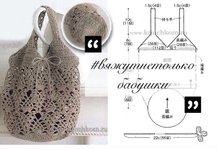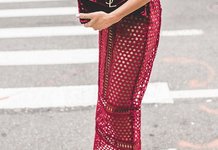
Today I propose to discuss a very important topic "How to crochet socks." These socks are more suitable for the cold season, so we will choose thick yarn. But if you are a needlewoman with experience, you can try a complex openwork model, which will take a lot of time.
How to crochet knit socks (schemes step by step in pictures)
How to quickly learn how to crochet socks for a child or adult, if you are still a beginner? Especially for you, we have collected the simplest and most interesting lessons from the best masters of the network. Starting with the simplest, we suggest moving on to the more complex ones, pleasing your home with warm, cozy new things.
Home women's woolen slippers on an adult foot (mk for women)
The knitting of this model will take a minimum of time, and if you follow all the recommendations correctly, in the future you can move on to more complex products.
Size 37-38 Yarn - “Village” from Troitsk, natural color (1508), 100% wool, 170 m / 100 g., Yarn consumption 100 g Hook number 3,5 Knitting density of the main knitting (crochet) Pg = 1.54 stitches in 1 cm, Pv = 1.8 rows in 1 cm Leg circumference (He) 23 cm Work description: We start knitting slippers from the toe. We make a sliding loop, we knit 6 single crochet into it, including 1 lifting air loop, then we knit a circle, obeying the main rule of knitting a circle: the number of columns added in each row should equal the number of columns in the first row, in our case - 6. We turn the work at the beginning of a new series. If you knit without turning the work, then the pattern on the toe and the rest of the slippers will differ in appearance. We knit until the circumference becomes equal to the circumference of the leg. Calculate the number of columns. It will be equal to the measure of leg circumference, multiplied by the horizontal knitting density: He x Пг = 23 x 1.54 = 35.42. Round off, we get 36 columns. That is, you need to knit in a circle with increments until we get 36 loops (columns). Given the circle rule, to get 36 columns you need to knit 6 rows. It is possible that according to your calculation, in the last row you will need to make fewer increments - this is not a big deal, just distribute the required number of increments evenly in a circle. Next, we continue to knit in a spiral already without increases. We knit the desired length of the toe, in this case, just below the bone of the thumb, which amounted to 7 cm or 14 rows. We knit the middle part of the slipper with a straight cloth. The middle part will have 2/3 of 36 columns, i.e. 24 columns. We continue to knit the middle part. We will make the slipper shorter than the foot by about 2 cm, so that it sits more densely on the foot.At this stage, it is possible to iron the middle part of the slipper, since the canvas knitted with crochets has the property of twisting. So the finished product will look neater. However, this can not be done: the slipper will sit on the leg well without it. Now we begin to form a heel. To do this, divide the loop into three parts. The number of loops of the middle part is 1/3 of 24 loops - 8 loops (columns) are obtained. If you got 1 loop in the balance, add it to the middle part, if 2 loops - one at a time to the side parts. We will form the heel with shortened rows. We begin to knit the heel from the wrong side.
We knit 8 single crochet of the first part, then 7 single crochet of the middle part, skip the 8th column of the middle part, and knit a connecting column in the first loop of the third part. The heel is obtained more accurately if the last, connecting column is knitted on the front side as usual, introducing the hook into the loop in the front, and on the wrong side - introducing the hook into the loop in the back. We turn the work to the front side.
Now we begin to form a heel. To do this, divide the loop into three parts. The number of loops of the middle part is 1/3 of 24 loops - 8 loops (columns) are obtained. If you got 1 loop in the balance, add it to the middle part, if 2 loops - one at a time to the side parts. We will form the heel with shortened rows. We begin to knit the heel from the wrong side.
We knit 8 single crochet of the first part, then 7 single crochet of the middle part, skip the 8th column of the middle part, and knit a connecting column in the first loop of the third part. The heel is obtained more accurately if the last, connecting column is knitted on the front side as usual, introducing the hook into the loop in the front, and on the wrong side - introducing the hook into the loop in the back. We turn the work to the front side.
 We knit the first column in a shortened row without a lifting loop in the first loop from the hook. Again, we knit 7 loops of the middle part with single crochet, and in the first loop of the side part we knit a connecting column, while the hook is inserted into the loop in front.
We knit the first column in a shortened row without a lifting loop in the first loop from the hook. Again, we knit 7 loops of the middle part with single crochet, and in the first loop of the side part we knit a connecting column, while the hook is inserted into the loop in front.
 We continue to properly knit the heel in the same way, attaching loops from the side parts. Finish knitting the heel with the front row. The result is such a neat heel. Now we tie the edge of the slipper (except the heel) with single crochet, slightly pulling the edge together for better fit of the slipper on the foot. Then we knit a row of connecting posts along the edge, already including the heel. Cut the thread and hide its end. Slipper is ready. We knit the second in the same way.
In our example, the finish is made of patchwork motifs, and at the end the edge is additionally tied with two rows of connecting posts with blue yarn. Motives are attached to the slipper in the process of tying the edge.
We continue to properly knit the heel in the same way, attaching loops from the side parts. Finish knitting the heel with the front row. The result is such a neat heel. Now we tie the edge of the slipper (except the heel) with single crochet, slightly pulling the edge together for better fit of the slipper on the foot. Then we knit a row of connecting posts along the edge, already including the heel. Cut the thread and hide its end. Slipper is ready. We knit the second in the same way.
In our example, the finish is made of patchwork motifs, and at the end the edge is additionally tied with two rows of connecting posts with blue yarn. Motives are attached to the slipper in the process of tying the edge.

Ideas for men
Men's socks for a loved one is the easiest way.
Size 42
Materials:
1. Plain woolen thin yarn for socks (in two additions)
2. Hook 2.5 mm
3. Hours 3 for each toe
We will knit a sock from the toe. The sock is connected by semi-columns!
Dial 4 in. n., close in a ring ... further according to the scheme.
The last row of the toe = 52 loops. Next, we continue to knit in a circle with semi-columns, adding 2 loops = 54 loops in the first row after the toe. 20 rows of 54 loops in each circular row. The seam is located on the sole.
For the heel, divide the loops in half. We knit on 27 loops of the sole. To do this, move back from the seam with connecting posts of 13 loops.
The bottom of the heel is a triangle. We continue to work with semi-columns.
Knit a triangle on 27 loops, decreasing one loop in each row on both sides (knit 2 half-posts together) until 1 loop remains on the hook.
Now we will perform the lifting wedge and the back of the heel together. To do this, dial 21 loops along the edge of the triangle on each side, on the front part that we did not touch, you should get 28 loops = total first circular row (I have it made with beige threads) 70 loops.
Side view. Note that the triangle is the bottom of the heel, not the entire heel. To form a lifting wedge, decrease on both sides of the top of the toe. Decrease = 3 half-columns tied together.
Decrease until 46 loops remain in the row. Only 10 circular rows.
Now the gum. Knit according to the pattern:
1 row: double crochet stitches
2 row: 2 in. p. lift, * front embossed double crochet, 1 simple double crochet *, repeat from * to * to the end of the row.
3-16 rows: 2 in. lifting point, * front embossed column in the embossed column of the previous row, double crochet into the crocheted column of the previous row *, repeat from * to * to the end of the row.
Done!
Knitted children's models (photo)
Children's legs should always be warm, so women love to delight kids with funny crafts with their favorite characters.
Simple booties for baby
Yarn: Souffle, Semenovskaya yarn, acrylic 100%, 292 m / 100 g. Yarn consumption 25 g. Instruments: hook number 2.5. The size: sole length 12 cm. Slippers booties are crocheted in columns. The sole is oval. See a detailed workshop on knitting soles and you can knit a sole of the size you need from your yarn. Sole length 12 cm. Width 6 cm. At the beginning we knit a chain of air loops 7 cm long or 13 loops, plus 1 air lifting loop. Having connected the sole according to the scheme, we obtain 56 loops along the perimeter of the sole. Side part
We knit the top of the booties with crochet in rotary rows. We knit the first row with the back (at work) embossed columns without a crochet for the formation of a welt. For lifting we knit one air loop.
We close the row with a connecting column, turn the work and knit the next row. Next, we continue to knit with crochets another 7 rows. Total side part is 8 rows. The height of the side can be from 2 to 3 cm. In our case, 3 cm.
Toe
We knit a toe in short rows. We find the center of the sole in the front: 13 loops of the middle part, plus 7 loops of the front - the 21st loop from the beginning of the row will be the middle of the boot in front. You can simply bend the booties in the middle.
From the center we mark 5 loops left and right. We determine the number of loops necessary for knitting a toe. The width of the toe is equal to the width of the sole or slightly less. In our case, this is 11 loops (columns). In the photo, the center of the toe is indicated by a pink marker, and the extreme loops of the toe are indicated by blue markers.
Side part
We knit the top of the booties with crochet in rotary rows. We knit the first row with the back (at work) embossed columns without a crochet for the formation of a welt. For lifting we knit one air loop.
We close the row with a connecting column, turn the work and knit the next row. Next, we continue to knit with crochets another 7 rows. Total side part is 8 rows. The height of the side can be from 2 to 3 cm. In our case, 3 cm.
Toe
We knit a toe in short rows. We find the center of the sole in the front: 13 loops of the middle part, plus 7 loops of the front - the 21st loop from the beginning of the row will be the middle of the boot in front. You can simply bend the booties in the middle.
From the center we mark 5 loops left and right. We determine the number of loops necessary for knitting a toe. The width of the toe is equal to the width of the sole or slightly less. In our case, this is 11 loops (columns). In the photo, the center of the toe is indicated by a pink marker, and the extreme loops of the toe are indicated by blue markers.
 9th row: We knit 15 loops of the side and 10 loops of the toe in single crochet, skip the loop, 1 connecting column;
10 row: We knit 10 loops of the toe with single crochet, skip the loop, connecting column.
Attention! The first loop in the row is dense, do not miss it.
9th row: We knit 15 loops of the side and 10 loops of the toe in single crochet, skip the loop, 1 connecting column;
10 row: We knit 10 loops of the toe with single crochet, skip the loop, connecting column.
Attention! The first loop in the row is dense, do not miss it.
 Next, we knit another 8 rows in the same way as the 10th row. A total of 10 rows. The toe takes approximately half of the booties in length.In the 19th row continue to knit booties in a circle and close the row. Loops in this row are not reduced. We tie the top of the booties with Rachchym step. We knit the second booties as well as the first. We decorated the booties with a bow crocheted. You can decorate booties to your liking.
Next, we knit another 8 rows in the same way as the 10th row. A total of 10 rows. The toe takes approximately half of the booties in length.In the 19th row continue to knit booties in a circle and close the row. Loops in this row are not reduced. We tie the top of the booties with Rachchym step. We knit the second booties as well as the first. We decorated the booties with a bow crocheted. You can decorate booties to your liking.
Crochet socks for beginners video tutorials (crochet)
A video tutorial with a detailed description helps to analyze in detail the entire knitting process. Thanks to accurate calculations and valuable comments by the master, the student is able to master even the most complex model.
Beautiful fishnet socks - master class
Openwork products look especially beautiful, but require more patience. Starting from the elastic band, you can tie them with the finest thread, creating the finest lace (short and tall styles look good).
Motif Boots
Socks sneakers for men
Female option
Knitting socks for newborns
The legs of the newborn should be warm, therefore I offer universal cool models for the smallest.
Crocodile boots for babies (step by step)
Children's sneakers-slippers for the boy
Homemade felt sole option
Interesting Slippers Minions




































Thank you so much for such a selection !! really want to learn how to knit openwork socks !!